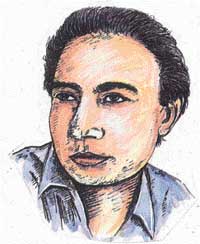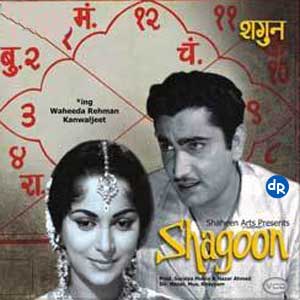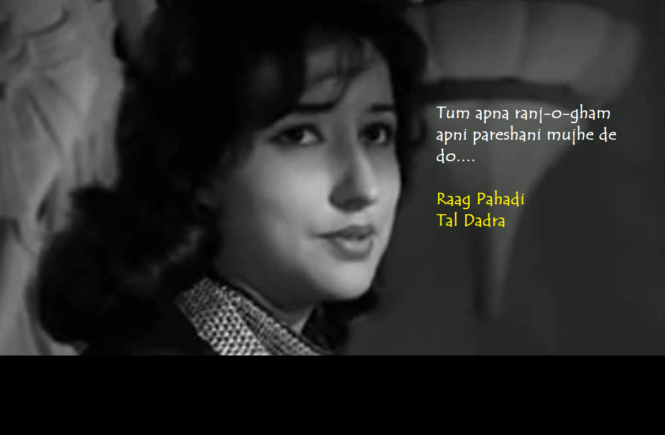Raaga Based Song of the Day: Tum apna ranj-o-gham, apni pareshani mujhe de do ….
Raag Pahadi, Tal Dadra

Ladies and gentlemen, it is time for Raag Pahadi, the raag of my place in the Himalayas and this is special to me because of all the three people who put it together: Sahir Ludhianvi, Khayyam and his wife Jagjit Kaur. The distance between Ludhiana (Sahir’s city) and the town of Rahon (where Khayyam was born) near Nawanshahr is only about 50 kms. I am much familiar with these places as a greater part of my childhood was spent in the village of Urapur (my maternal grandparents place), roughly 16 kms from Rahon and 34 Kms from Ludhiana.
Why should I be fond of Khayyam’s songs other than the place connection? Well, simple; he has Raag Pahadi as his favourite raag and many of his songs are composed in this. These include the film Noorie’s Chori chori koi aaye and the title song: Aaja re aaja re mere dilvar aaja. There is one more reason and that is that Mohammad Zahur Khayyam Hashmi decided to donate his entire wealth of about Rupees Ten Crores to the trust founded by him as KPJ Trust (K for Khayyam, P for their late son Pradeep (they lost him in 2012) and J for his wife Jagjit) to support budding artists and technicians in India.
Jagjit Kaur, his wife, belongs to a wealthy Punjabi zamindari family. Her marriage to Khayyam was an inter-caste wedding, looked down upon by her immediate society. She has sung only a few songs in Hindi movies and she has the distinction that all of these are memorable songs including the one I am giving now.
 Sahir Ludhianvi, the lyricist of this song, was born in a Muslim Gujjar family in Karimpura village of Ludhiana in Punjab. He had to, at a very young age, witness his father being estranged from his mother, his mother Sardar Begum leaving his father and forfeiting all claims to his property, and his father making abortive attempts to get custody of him (Abdul Hayee was the name he was born with). Interestingly, many of Sahir’s songs reflect the condition of women in the society including the famous: Aurat ne janam diya mardon ko. Sahir got composer Khayyam his first Filmfare Award for the title song of 1976 movie Kabhi Kabhi, for which he received his second and last Filmfare Award as Music Director (after Taj Mahal in 1963).
Sahir Ludhianvi, the lyricist of this song, was born in a Muslim Gujjar family in Karimpura village of Ludhiana in Punjab. He had to, at a very young age, witness his father being estranged from his mother, his mother Sardar Begum leaving his father and forfeiting all claims to his property, and his father making abortive attempts to get custody of him (Abdul Hayee was the name he was born with). Interestingly, many of Sahir’s songs reflect the condition of women in the society including the famous: Aurat ne janam diya mardon ko. Sahir got composer Khayyam his first Filmfare Award for the title song of 1976 movie Kabhi Kabhi, for which he received his second and last Filmfare Award as Music Director (after Taj Mahal in 1963).
We have completed seventy-nine days of Raaga Based Songs of the Day. Our first post in the series was titled ‘Raaga Based Song Of The Day #1’ and the song was a Mohammad Rafi and Lata Mangeshkar song from the 1970 Shakti Samanta movie Pagla Kahin Ka: Tum mujhe youn bhula na paoge. It is in Raag Jhinjhoti, Tal Kaherava.
Our seventy-ninth post or the last post was titled ‘Raaga Based Song Of The Day #79‘ and the song was a Mukesh song from the 1959 Hrishikesh Mukherjee movie Anari starring Raj Kapoor and Nutan: Sab kuchh seekha hamne na seekhi hoshiyari. It is in Raag Bhairavi, Tal Kaherava.
This blog has a number of posts on Raaga based songs in Hindi movies titled similarly; for example: ‘The Best Raaga Based Songs in Hindi Movies – Raaga Darbari Kanada – Part I‘.
In the last seventy-nine days of sharing Raaga based songs of the day, I have given you songs based on Raag Jhinjhoti, Gara, Bhimpalasi, Madhuvanti, Shivaranjani, Bihag, Pahadi, Sarang, Pilu, Bhairavi, Khammaj, Charukesi, Kalyan or Yaman, Desh, Malgunji, Kirwani, Kedar, Bageshri, Megh Malhar, Bhupali, Ahir Bhairav, Malkaush, Mand, Adana, Kafi, Rageshri, Jaunpuri, Tilang, Janasammohini, Chayanat, Shuddha Kalyan, Gaur Sarang, Jogiya, Asavari, Maru Bihag, Durga, Lalit, Puria Dhanashri, Bhinna Sahdja, Sohani, Multani, Patdeep, Jaijaiwanti, Tilak Kamod, Hemant, Basant Mukhari, Gujri Todi, Kalavati, Hamir, Bhatiyar, Gawati, Shyam Kalyan, Gorakh Kalyan, Madhamat Sarang, Manj Khammaj, Darbari Kanada, Vibhas, Shankara, Bahar, Nand and Mian Ki Malhar; making it a total of 61 raagas. The raagas that have been repeated so far are Pahadi, the raaga of my home place in the Himalayas, Maru Bihag, Raag Kirwani, Jhinjhoti, Bhairavi, Gara, Basant Mukhari, Malkauns, Bhairavi and Mand. Today, I am repeating Raaga Pahadi again.
Today’s song has been sung by Jagjit Kaur on the lyrics of Sahir Ludhianvi and composition by Khayyam. As I said, it is in Raag Pahadi, Tal Dadra.
Before we actually take up the song, first, lets take up the value added learning of today. We have already taken up quite a few Tala or Taals or Tals. Today, we shall take up Tivra Tal. I have so far told you about Tal and its various characteristics and then taken up with you the following Tals: Kaherava, Dadra, Tintal, Dipchandi, Punjabi Theka or Sitarkhani, Ektal, Rupak Tal and Jhaptal.
Tivra Tal, is also referred to as tivratal, teevra, or teevra Tal. It was a common 7-matra tal of Hindustani Music, used extensively in Dhrupad style of music.
Tivra is part of the pakhawaj (a North Indian version of Mridangam) tradition. This tradition did not have a single theka that I told you about, but instead used a series of simple accompaniment patterns known as thapi.
Tivra tal began to fall out of fashion as the Dhrupad fell out of fashion in the last century. Just as the Khayal replaced Dhrupad, Rupak Tal replaced Tivra.
The Clap and Wave arrangements are:
clap, 2, 3, wave, 2, clap, 2
And the Theka is:

As I said, today’s song is in Raag Pahadi, Tal Dadra.
Why do I have this urge to get back to Pahadi? On the tenth day, I had covered for you, the sources of names of raagas and mentioned that raagas like Marwa, Jaunpuri, Mand and Pahadi were named after places. Pahadi is not a place, in the same manner, as Marwa, Mand and Jaunpur. You should expect Pahadi anywhere you see pahad or hills but actually the name is from hills in Himalayas, my home place. It is a light raaga and is more akin to being a dhun.
Pahadi is a very beautiful raag. Soundofindia.com describes it beautifully: the raga is like a lover, unruffled in union, serene in separation, powerful enough to achieve eternal union, but resigned to the painful parting ordained by destiny.
All raagas are supposed to transport you to the mood of the raaga (bhaav). But, none other does it better than Pahadi: you can’t escape the freshness, quiet, wetness, echoing effect and palpable romance of the hills. It is as if the raaga says to you: ‘Love is in the air’.
I am not giving you again a list of songs composed in Raag Pahadi as I have already given you this elsewhere.
 The song Tum apna ranj-o-gham, apni pareshani mujhe de do is from the 1964 Nazar movie Sahgun starring Waheeda Rehman and her husband Kamaljit. Some part of the movie was shot in Nainital where I was scheduled to go this September for a holiday; but, for the sad demise of my mother. I enjoy another two songs from the movie: Parbaton ke pedon par shaam ka basera hai (Also in Raag Pahadi sung by Mohammad Rafi and Suman Kalyanpur) and Tum chali jayogi parchhaayian reh jaayengi sung by Mohammad Rafi.
The song Tum apna ranj-o-gham, apni pareshani mujhe de do is from the 1964 Nazar movie Sahgun starring Waheeda Rehman and her husband Kamaljit. Some part of the movie was shot in Nainital where I was scheduled to go this September for a holiday; but, for the sad demise of my mother. I enjoy another two songs from the movie: Parbaton ke pedon par shaam ka basera hai (Also in Raag Pahadi sung by Mohammad Rafi and Suman Kalyanpur) and Tum chali jayogi parchhaayian reh jaayengi sung by Mohammad Rafi.
Please enjoy in Raag Pahadi, Tal Dadra: Tum apna ranj-o-gham, apni pareshani mujhe de do ….
Tum apanaa ra.nj-o-Gam, apanI pareshaanI mujhe de do
Tumhe.n Gam kii qasam, is dil kI vIrAnI mujhe de do (?)
Ye maanaa mai.n kisii qaabil nahii.n huu.N in nigaaho.n me.n – 2
Buraa kyaa hai agar, ye dukh ye hairaanI mujhe de do
Tum apanaa …
Mai.n dekhuu.N to sahii, duniyaa tumhe.n kaise sataatI hai – 2
KoI din ke liye, apanI nigahabaanI mujhe de do
Tum apanaa …
Vo dil jo maine maa.ngaa thaa magar gairo.n ne paayaa – 2
Ba.DI inaayat hai agar, usakI pashemaanI mujhe de do
Tum apanaa …
https://www.youtube.com/watch?v=A8Yr1OOeOT8
We have intended to learn about Raaga based music whilst we entertain ourselves with Raaga based songs. So, lets, once again, take stock of our collective learning so far:
- On the first day we learnt about the Raaga system devised by Pandit Vishnu Narayan Bhatkhande, which is the prevalent system in Hindustani Classical Music and based on ten Thaats.
- On the second day we learnt about Tal or Taal.
- On the third day we learnt about characteristics of Raagas that included Swar, Jati, Thaat, Arohana and Avarohana, Vadi, Samvadi and Pakad.
- On the fourth day, we learnt about Sargam.
- On the fifth day, we learnt about notations used in Indian classical music or simply Swar Lipi.
- On the sixth day, we learnt about the Ras (sentiments) that Raagas evoke.
- On the seventh day, we learnt about various types of Swar: Shuddha, Achal, Vikrut, Komal and Teevra.
- On the eighth day, we learnt the parts of a composition in Indian Classical Music.
- On the ninth day, we learnt the names of some of the popular instruments used in Indian Classical Music.
- On the tenth day, we learnt about the sources of names of Raagas.
- On the eleventh day, we learnt about why Bhairavi is the first raag to be taught to beginners and also why it is the last in a performance.
- On the twelfth day, we learnt about Khammaj Thaat.
- On the thirteenth day, we learnt about Tal Punjabi Theka or Sitarkhani.
- On the fourteenth day, we learnt about Alap.
- On the fifteenth day, we learnt about List of Raagas (Raagmala) in my favourite book: Sri Guru Granth Sahib.
- On the sixteenth day, we learnt about tips for raaga identification.
- On the seventeenth day, we learnt the basics of Gharana system.
- On the eighteenth day, we learnt about Filmi Sangeet.
- On the nineteenth day, we learnt about the commonest Tal in Raagas: Tintal.
- On the twentieth day, we learnt about the Kafi Thaat.
- On the twenty-first day, we learnt a little more in detail about the classification of Raagas.
- On the twenty-second day, we learnt the essential differences between Bhairavi and Bhairav.
- On the twenty-third day, we learnt a little more in detail about the Jati or Jaati of a raaga.
- On the twenty-fourth day, we learnt details of Thaat Bilawal, the most basic thaat in the Bhatkhande’s system of raagas.
- On the twenty-fifth day, we learnt about Tintal.
- On the twenty-sixth day, we learnt in detail about the Raaga – Samay linkage.
- On the twenty-seventh day, we learnt about Lehar.
- On the twenty-eighth day, we learnt about the history of the Hindustani Music.
- On the twenty-ninth day, we learnt about Dhrupad.
- On the thirtieth day, we learnt about Rupaktal that I was introduced to, a few months back, by my friend Anand Desai.
- On the thirty-first day, we learnt about Khayal.
- On the thirty-second day, we learnt about Thumri.
- On the thirty-third day, we learnt about Tappa.
- On the thirty-fourth day, we learnt about Tarana.
- On the thirty-fifth day, we learnt about Tal Dipchandi (Moghali).
- On the thirty-sixth day, we learnt about Tabla.
- On the thirty-seventh day, we learnt about Kirtan.
- On the thirty-eighth day, we learnt about Pakhawaj.
- On the thirty-ninth day, we learnt about Hori.
- On the fortieth day, we learnt about Dadra.
- On the forty-first day, we learnt about Kajri.
- On the forty-second day, we learnt about Chaiti.
- On the forty-third day, we learnt about Sarangi.
- On the forty-fourth day, we learnt about Shehnai.
- On the forty-fifth day, we learnt about Sarod.
- On the forty-sixth day, we learnt about Bansuri.
- On the forty-seventh day, we learnt about Ektal and Tanpura.
- On the forty-eighth day, we learnt about Veena.
- On the forty-ninth day, we repeated our learning of Veena with a small excitement added.
- On the fiftieth day, we learnt about Dilruba/Esraj.
- On the fifty-first day, we learnt about Jaltarang.
- On the fifty-second day we learnt about Qawwali.
- On the fifty-third day, we learnt about Sitar.
- On the fifty-fourth day, we learnt about Surbahar.
- On the fifty-fifth day, we learnt about Harmonium.
- On the fifty-sixth day, we learnt about Santoor.
- On the fifty-seventh day, we learnt about Swarmandal.
- On the fifty-eighth day, we learnt about the Shruti Box.
- On the fifty-ninth day, we learnt about Alankar.
- On the sixtieth day, we learnt about singing in Aakaar.
- On the sixty-first day, we learnt about the Classification of Indian Musical Instruments.
- On the sixty-second day, we learnt a little about Carnatic Music.
- On the sixty-third day, we learnt about Natya Shastra.
- On the sixty-fourth day, we learnt about evolution of musical instruments in India down the ages.
- On the sixty-fifth day, we learnt about Riyaaz.
- On the sixty-sixth day, we looked at a list of Raagas in Hindustani Classical Music.
- On the sixty-seventh day, we learnt about the health benefits of raagas.
- On the sixty-eighth day, we learnt a little more comprehensively about the moods and emotions that raagas evoke.
- On the sixty-ninth day, we learnt about a mobile application to help identify raagas.
- On the seventieth day, we learnt about Melakarta Raagas.
- On the seventy-first day, we learnt about Sangita Makarand.
- On the seventy-second day, we learnt about TaalMala an Android application for personalized accompaniment of musical instruments during Riyaaz or even during Concert.
- On the seventy-third day, we learnt about Indian Classical Ragas, an Android application for mobile phones.
- On the seventy-fourth day, we learnt about Saregama Classical, another application for Classical Raagas.
- On the seventy-fifth day, we learnt about a free online service available to learn Indian Classical Music.
- On the seventy-sixth day, we learnt about List of Hindustani Classical Musical Festivals in India and Abroad.
- On the seventy-seventh day, we learnt about List of Carnatic Musical Festivals in India and Abroad.
- On the seventy-eighth day, we learnt about Jhaptal.
- On the seventy-ninth day, we learnt about Ektal.
- And today, on the eightieth day, we learnt about Tivra Tal.
There is much more still to be learnt and enjoyed.
Please stay tuned!

Outstanding Post
Thank you